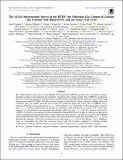The ALMA Spectroscopic Survey in the HUDF: the Molecular Gas Content of Galaxies and Tensions with IllustrisTNG and the Santa Cruz SAM
Author(s)
Marinacci, Federico; Vogelsberger, Mark
DownloadPublished version (6.054Mb)
Publisher Policy
Publisher Policy
Article is made available in accordance with the publisher's policy and may be subject to US copyright law. Please refer to the publisher's site for terms of use.
Terms of use
Metadata
Show full item recordAbstract
© 2019. The American Astronomical Society. All rights reserved.. The ALMA Spectroscopic Survey in the Hubble Ultra Deep Field (ASPECS) provides new constraints for galaxy formation models on the molecular gas properties of galaxies. We compare results from ASPECS to predictions from two cosmological galaxy formation models: The IllustrisTNG hydrodynamical simulations and the Santa Cruz semianalytic model (SC SAM). We explore several recipes to model the H2 content of galaxies, finding them to be consistent with one another, and take into account the sensitivity limits and survey area of ASPECS. For a canonical CO-to-H2 conversion factor of CO = 3.6 M o/(K km s-1 pc2) the results of our work include: (1) the H2 mass of z > 1 galaxies predicted by the models as a function of their stellar mass is a factor of 2-3 lower than observed; (2) the models do not reproduce the number of H2-rich () galaxies observed by ASPECS; (3) the H2 cosmic density evolution predicted by IllustrisTNG (the SC SAM) is in tension (in tension but with less disagreement than IllustrisTNG) with the observed cosmic density, even after accounting for the ASPECS selection function and field-to-field variance effects. The tension between models and observations at z > 1 can be alleviated by adopting a CO-to-H2 conversion factor in the range CO = 2.0-0.8 M o/(K km s-1 pc2). Additional work on constraining the CO-to-H2 conversion factor and CO excitation conditions of galaxies through observations and theory will be necessary to more robustly test the success of galaxy formation models.
Date issued
2019Department
Massachusetts Institute of Technology. Department of Physics; MIT Kavli Institute for Astrophysics and Space ResearchJournal
Astrophysical Journal
Publisher
American Astronomical Society